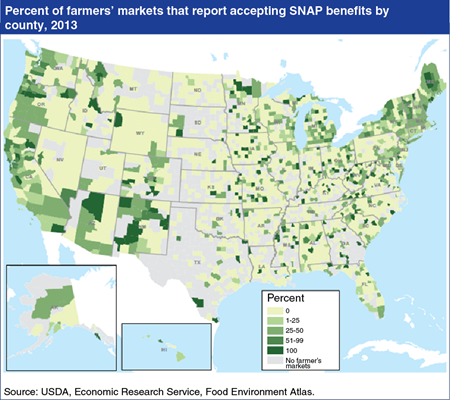Last week, the USDA Economic Research Service (ERS) released an updated and expanded Food Environment Atlas, with 2012 data for many variables and 2013 data for farmers’ markets. New variables include SNAP policy variables, the Food Distribution Program on Indian Reservations (FDPIR), very low household food security, and 2012 State-level obesity rates.
The Food Environment Atlas is an interactive online mapping tool that compares U.S. counties in terms of communities’ access to affordable, healthy food. Data is searchable by county as well. Introduced in 2010 as part of First Lady Michelle Obama’s Let’s Move! initiative, the Food Environment Atlas includes information on population, health indicators, food dollars in an area, and availability of farmers markets and farm to school programs.
An example of a data set available in the Atlas is the percentage of farmers’ markets across counties that currently accept SNAP (Supplemental Nutrition Assistance Program, formerly known as food stamps) benefits, as shown below:
With the recent expansion and update, the Atlas will provide a more comprehensive measure of a community’s food environment. Such data will also be important to help understand the interplay of direct-to-consumer marketing channels, such as farmers markets, and healthy food access, especially among low-income communities. As more farmers markets are able to secure EBT (Electronic Benefits Transfer) equipment to be able to process SNAP benefits, more consumers will have access to fresh, healthy, and locally produced foods, while more farmers producing for their local communities will be able to access a larger customer base and have increased income stability.
In the new 2014 Farm Bill, a provision allows farmers markets and other direct-to-consumer marketing outlets an exemption from having to pay all of their EBT equipment and installation costs. Such an exemption would make it easier for more direct-to-consumer outlets, such as farmers markets, to be able to accept SNAP benefits. This provision, which NSAC championed in the Local Farms, Food, and Jobs Act and advocated for inclusion in the farm bill, is one of several that USDA will implement to help more communities have better access to healthy and locally produced food.
In addition to showing the accessibility to healthy and local food in the U.S., the Atlas also demonstrates the increased need and interest in data collection on these topics. As a sector that has been rapidly growing over the past decade, local food has only recently become the subject of research and evaluation. In the new farm bill, a Local Food Production and Program Evaluation Initiative (also a product of the Local Farms, Food, and Jobs Act) aims to support research and evaluation efforts by providing for the collection of important data to understand local food systems. The Initiative is also geared to monitor and evaluate the impacts of local food systems and the effectiveness of federal programs designed to facilitate those systems. Unfortunately, no funding was authorized in the farm bill to carry out this program. As USDA works on implementing the farm bill, NSAC will be working to help get this and other initiatives that promote healthy and sustainable food environments off the ground.


